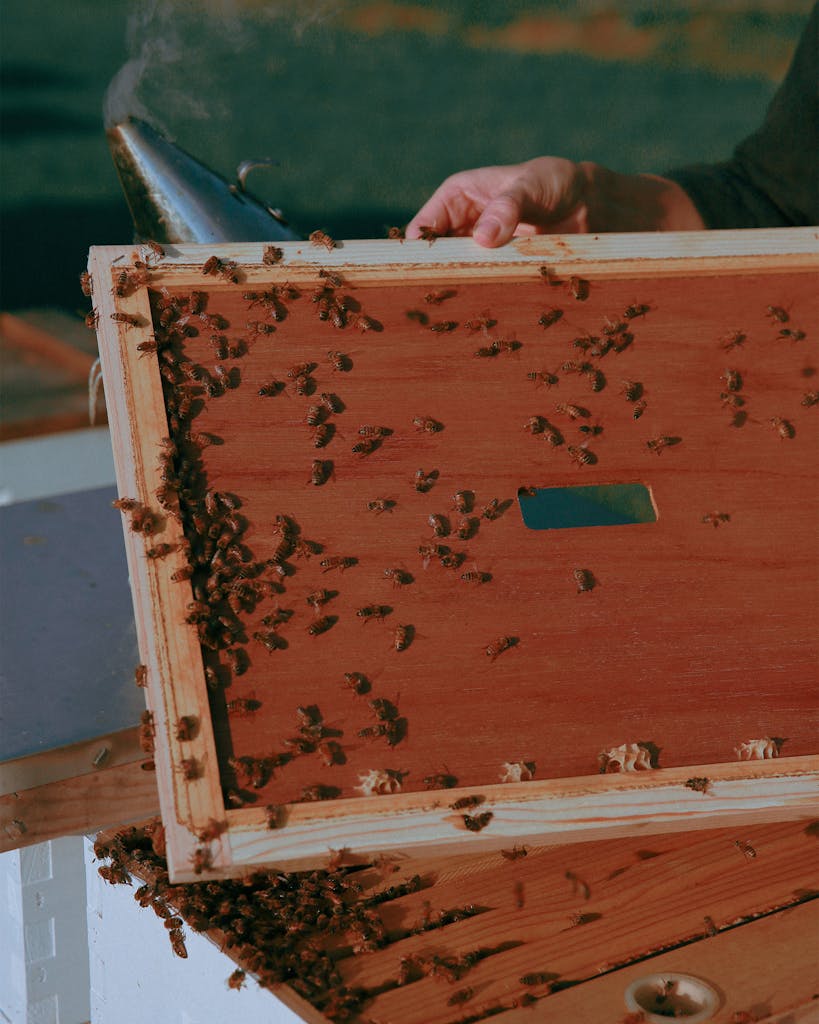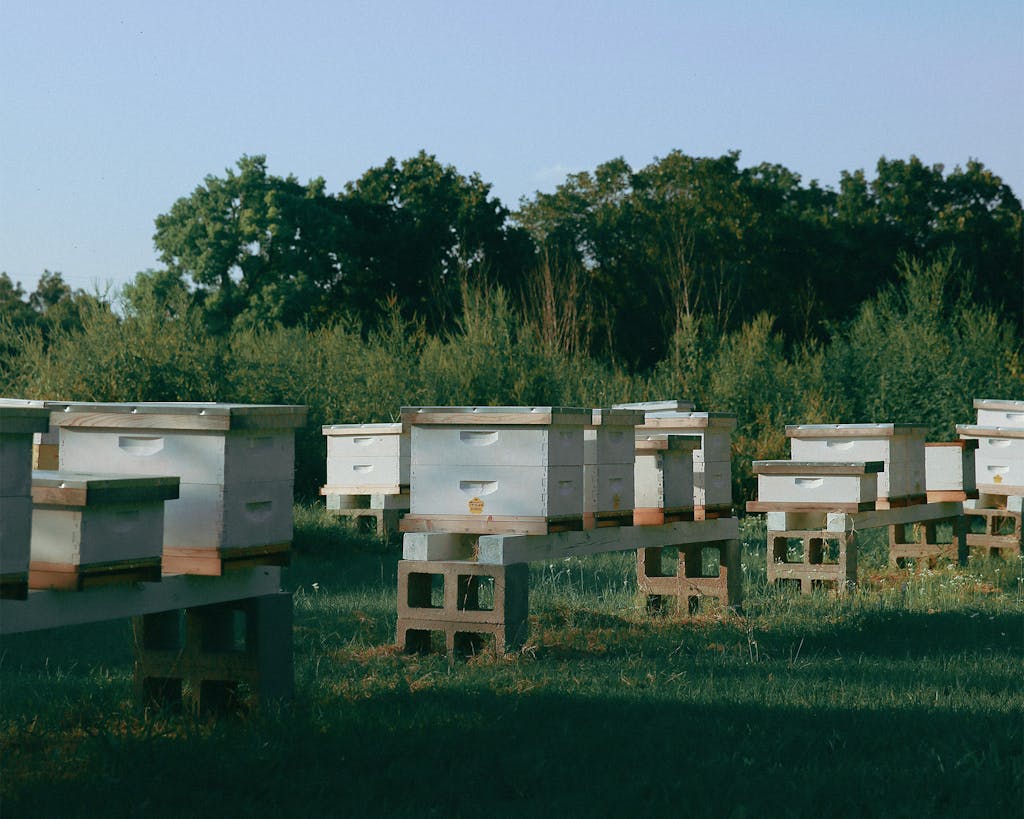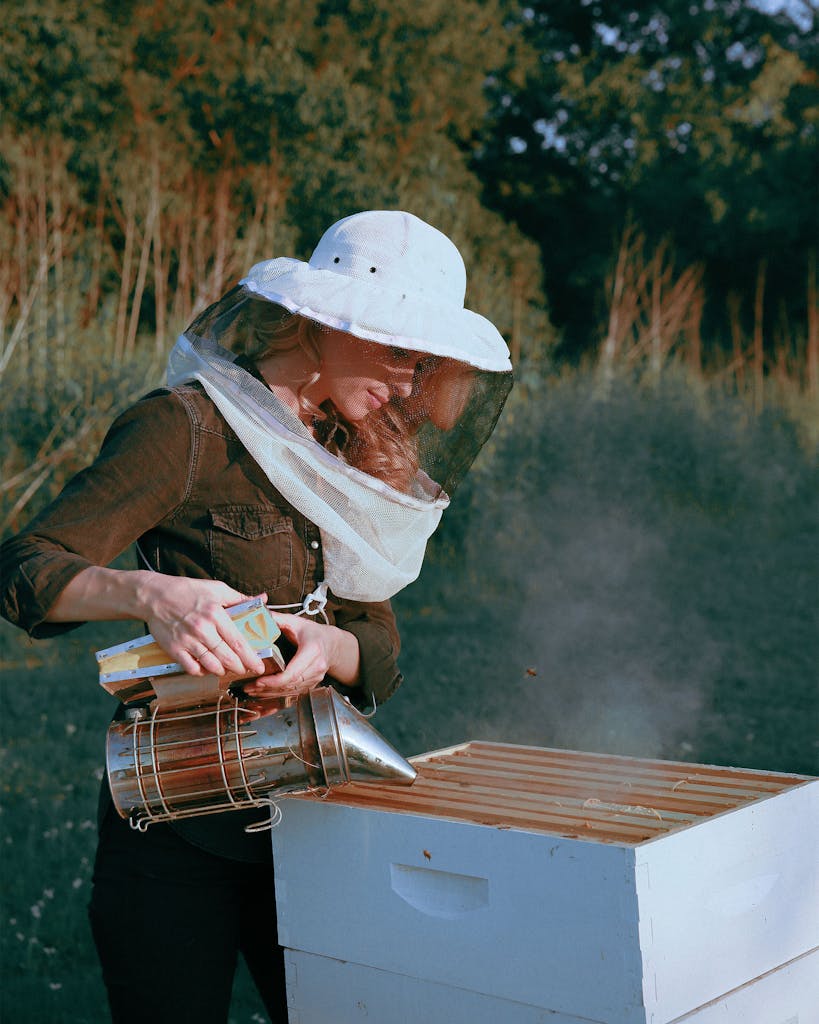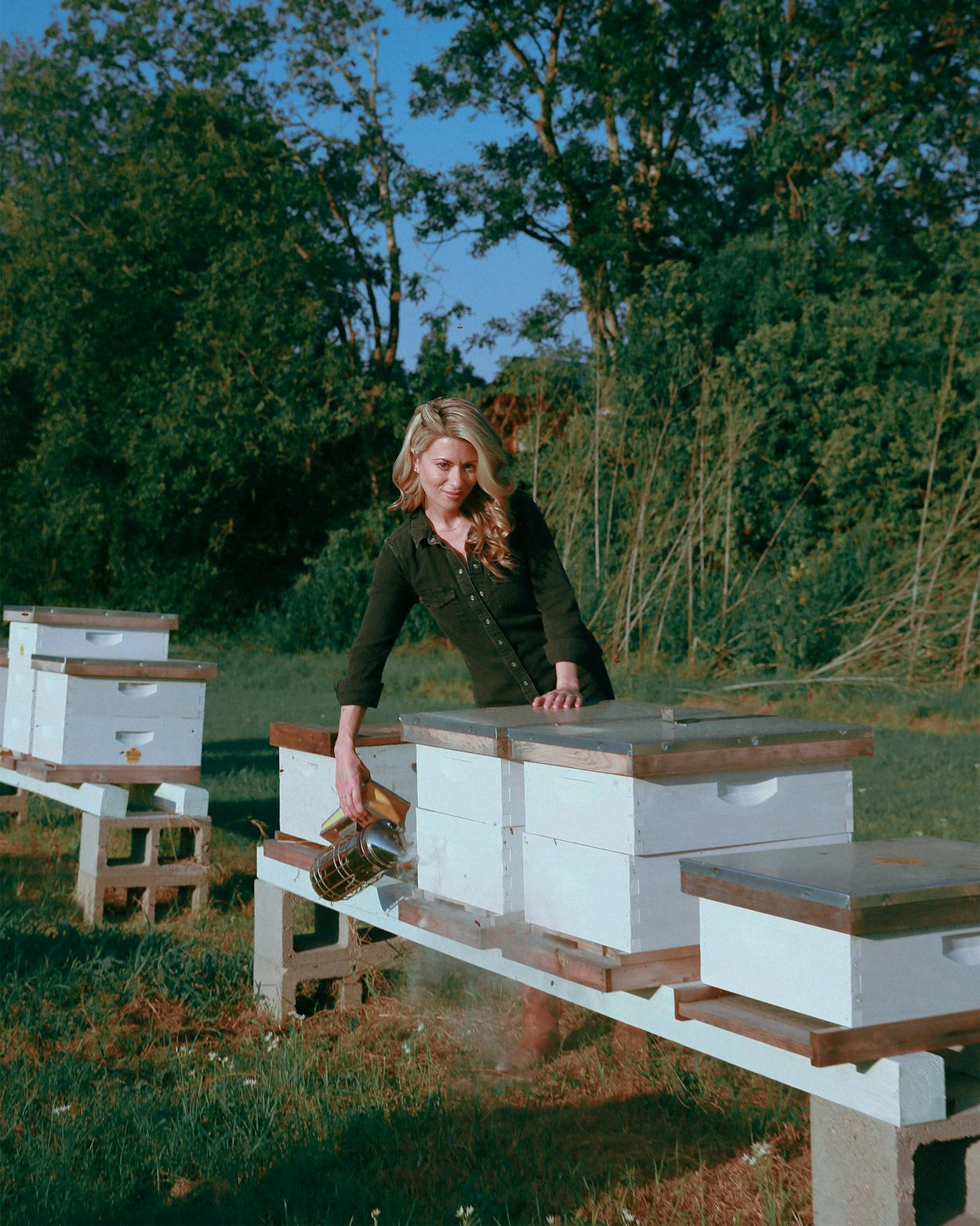A few years ago, when Erika Thompson was living in Austin, she came across a dove languishing on the sidewalk. She scooped the dove up, took him home, and nursed him back to health. Thompson hoped to release him into the wild when he was ready, but he refused to fly.
The dove, Lime, now perches on the back of one of Thompson’s dogs, a wiry mutt named Shelby. “We think Lime likes the fur,” Thompson says, watching the pair serenely for a few seconds. The cross-species harmony is broken when Thompson’s husband, Andrew Hollister, suddenly opens their house’s back door. Shelby hurls herself towards Hollister and Lime does a ruffled loop before perching on a nearby table. Thompson sighs. “That’s about as much as he flies,” she says, coaxing Lime onto an outstretched finger. Lime has settled into the Thompson menagerie, along with her three dogs, five chickens, and millions of bees.
Thompson, 34, is a beekeeper, a TikTok star, and a woodland Disney princess. Her life is a pastoral idyll. Every day she has a slice of pumpkin pie for breakfast; sometimes she takes her coffee riverside, surrounded by her three dogs. She suspects the nearest H-E-B keeps one pumpkin pie per week in stock year-round, just for her.
On one of the first tolerably warm days in September, she walks me around her place near Elgin, which she and Hollister bought last year. “When we first saw this property, we’d been looking for a while. I just wanted to get out of town,” Thompson says. As a beekeeper with her own company, Texas Beeworks, she needed more space for her beekeeping equipment, and she wanted to be able to keep hives closer to home.
A significant part of her business is removing unwanted colonies from people’s properties, a process which can take anywhere from 45 minutes to four hours, depending on the size of the hive. When she lived in Austin, after each removal she had to drive the bees to one of her apiaries across Central Texas. (In Texas, homeowners who host colonies on their properties can qualify for agricultural tax exemptions.)
Now she just takes the bees home to her apiary, two long rows of stacked white wooden boxes a short walk from her house. “I just drive around, go inside, and have dinner. It’s the best.”
She and Hollister liked the house, which is pink and unpretentious. But mostly they were drawn to the quirks of the surrounding land. Thompson shows me the hundred-year-old pecan tree in the backyard, where she and Hollister had a pandemic-size wedding ceremony this month. (They met on Bumble.)
A ways off from the pecan tree, Thompson and Hollister keep a brood of chickens in a spacious coop. She opens the coop’s door so “the girls”—all named after female country singers—can peck around in the grass. The chickens meander out of the coop and stand around for a moment, like a clique getting their bearings at a middle school dance. Then, suddenly, they race off as one, rounding the house.
Thompson hurries after them, shaking a bag of feed. All but one of the chickens follow her back and allow her to corral them back into the coop—a small gray lady named Emmylou is missing. “She loves the trash,” Thompson explains. She creeps up to the trash cans behind the house, from which a twitching gray chicken tush is peeking out. She shakes the bag again, then calmly herds Emmylou back into the coop.
Then Thompson leads me to a corner of the backyard where a path leads down to the Colorado River. When the previous owner showed them the house, Thompson recalls, she guided them to this spot and said, “We can walk down to the river if you want, but I have to tell you something: in this log, there is a beehive.” She presented it as a possible dealbreaker, not knowing that Thompson had been beekeeping for almost a decade. Thompson was thrilled. “It’s just such a good reminder that bees are going to do this with or without me,” she says of the hive, “and we’re gonna stand under that tree and get married, and there’s a beehive!” To each bride her own.
Now Thompson approaches the wild hive, keeping a reverent distance. The log is large and hollowed out, and bees clamber over each other at the mouth of the hollow. “I just love seeing how the entrance changes, and how their activity changes, without any intervention from a beekeeper,” she says pensively. “It’s so cool to me.”

Though Thompson technically makes a living in agriculture, which can seem antithetical to wildness, she has an unusual respect for animality. Her esteem for nature manifests itself in her beekeeping practice—though she occasionally collects honey from her bees to donate locally or gift to friends, she talks about honey harvesting with some derision—and in smaller ways.
As she walks past the house on her way to her truck to gather her beekeeping tools, three dog snouts appear over the sill of one window and begin howling. “Oh, thank you,” she says to the dogs, in a high, loving voice. “Thank you so much!”
Thompson’s deep understanding of and appreciation for animal behavior allows her to get very close to her bees, an intimacy that plays well on video-sharing platform TikTok. When Thompson began posting videos on TikTok this past spring, she quickly catapulted into the viral vortex. Six months since her first post, she has amassed 1.9 million followers.
In one particularly popular removal video from August, which has been viewed 38.4 million times, Thompson used her bare hands to scoop clusters of bees from a colony in a compost bin into their new hive. (Bees often settle in compost bins and water meter boxes, the latter because the boxes are underground and thus climate-controlled, and the hole at the top is an easy entrance for bees to defend.)
When she found the queen bee, Thompson put her in a tiny plastic container that looked like a hair clip, placed her in the box, and let the other bees follow her in.
In her videos, Thompson moves slowly and purposefully, and she looks calm and content. In a voice-over, she narrates the process. Before she turned to beekeeping full-time last year, Thompson was a communications director, and while a background in communications does not necessarily guarantee that one is a good communicator, Thompson is: her voice has the uncondescending warmth of a kindergarten teacher’s.
In the comments below the video from August, viewers lost their minds, many of them balking over Thompson’s lack of gear. Unless she notices signs of aggression from the bees she’s inspecting, Thompson rarely wears a suit when she does her bee work: she does get stung occasionally, but she doesn’t mind. “How is she not scared[?] when I see a bee [I] pass out for a year,” one commenter wrote. “I just really love bees!” Thompson replied.
Thompson thinks people like to see their preconceived notions about beekeeping upended. “I think it’s probably good that people have a healthy fear of bees. We should respect them—they can be very hurtful to people,” she says. “But I think it was very much an element of seeing someone handle creatures that you normally don’t see people that hands-on with.”


Besides the shock value of seeing someone so hands-on with a sometimes-maligned species, Thompson’s TikToks are very soothing, and they tap into our innate fascination with bee behavior.
When Thompson took a crash course on beekeeping a decade ago, she had no intention of becoming a beekeeper; she was just curious about honeybees as a species, particularly because she’d heard they were imperiled.
She’d dabbled in bugs as a child, until she was sixteen, when she got her first dog, a dalmatian that she brought to college at the University of Texas (the dog lived in her dorm room for a time). The beekeeping course renewed her interest in insects. Before she started her own colonies—first a small backyard hive, then a few on a friend’s property—she read everything she could about bees. But Thompson doesn’t just have an extensive knowledge of bee behavior; she can demystify it.
For instance, there’s a reason why you don’t often see male bees out and about, Thompson explains: the mating happens in “drone congregation areas” hundreds of feet up in the sky. She pops open her van’s back doors and gathers a few tools. Bees fly out of the van and circle her with a deep, ominous hum. She doesn’t seem to notice them.
“When a drone male bee mates with a queen, his endophallus rips out of his abdominal cavity, and he falls to the ground,” she continues cheerfully. If you see a male bee on the ground, he’s probably in the grip of post-coital paralysis.
The lady bees run the show; the male bees are secondary to all operations. “They’re not out in the world doing bee work,” Thompson says. They don’t forage, they don’t build the hive because they don’t have wax glands, and they don’t defend the hive, because they don’t have stingers. Typical.
“In the winter, the female worker bees will kick all the male drone bees out of the hive because they are a draw on the resources, and they won’t let them back in. They’ll either starve or freeze to death. Isn’t that crazy? Like, they have figured this out!” She shuts the van’s doors heavily, and we set off for her apiary.
Watching Thompson handle bees is like watching a circus sword-swallower: you know that they have practiced enough that what they’re doing is no longer dangerous, but you still feel a primal hnnnrgh watching it happen.
Thompson first looks at the entrance to the hive to read the bees’ bee-havior (sorry). “If there’s a bunch of guard bees out and a bunch of other bees trying to rob them, that might mean they’re a little more defensive,” she says.
“This is really good. We’ve got little lady bees coming and going; we’ve got one bee actually cleaning this other bee.” Satisfied, Thompson moves to the back of the hive and gently lifts the lid off the box on top of the stack. She sets it down nearby, careful not to crush any bees.

“Hey, babies, how are you doing?” she says in the same octave she uses to converse with her dogs. She pumps smoke on the bees—to calm them, she explains—from her metal bee smoker, a witchy-looking device filled with pine needles and other kindling. (The smoke obscures the smell of the pheromones bees release when they’re alarmed.) The bees scatter but begin an angry-sounding drone that lasts for a few seconds. Thompson, unperturbed, studies the hive and waits for the bees to go quiet before lifting each piece of comb.
Though the day is relatively cool for late summer, the bee suit I’m wearing over my jeans and T-shirt has begun to feel suffocating in the heat. (Additionally, because Thompson warned me that bees can confuse the smell of bananas with the smell of the pheromone they emit when a colony is queen-less, I have not eaten bananas for two weeks.) I feel like a fish fillet in a sous vide bag. While I cook, Thompson, wearing jeans and a long-sleeved button-up, studies the bees closely, apparently unaffected by the weather. She is committed to showing me a queen bee and a male bee.
The queen, the largest bee present, is easy to spot: in one hive, Thompson lifts out a comb and hands it to me. “See her?” she asks. A wall of identical bees moves in my hands. Sometimes I can’t recognize the queen bee even when Thompson points her out in her removal videos, but this time I do. Thompson ordered this queen, and she has a neon-blue marking on her back.
But when Thompson points to a male bee at the bottom of one comb—the male bees are thicker than the worker bees, and they have bigger eyes—I don’t see it, even though she is following its path closely with her finger.
Behind the bees, some of the combs are uniformly yellow and clean-looking. They look almost machine-made. Others are darker and messier. There are food combs and brood combs, Thompson explains. The food combs look like stone, with all the same variations—some parts look exactly like a Himalayan salt rock—while the hexagons of the brood combs, where eggs are stored, look like they’ve been stuffed with ground-up graham crackers.
“I just think there’s so much beauty to this texture—and the fact that these insects have built all of this, and how tiny they are,” she says, sounding moved. “They’re just in there doing their work.”
Thompson holds each comb up to eye level. Congratulating the bees for their good work, she makes some notes describing their progress on top of each box. “Thank you, bees,” she says before putting the lid back on. “We appreciate you.”

Post-bees, we sit on Thompson’s porch drinking ice-cold flavored seltzers, looking out over her front yard and the brambles that separate us from her apiary. TikTok, I suggest, seems at odds with the peaceful life that Thompson has created for herself.
On the surface, Thompson appears to be well suited to social media stardom. She looks, in her TikToks and in-person, like she’s just walked through a flattering Instagram filter: her blond hair is loosely, perfectly curled; her skin is Glossier-dewy; her makeup, suspiciously unsmudged even after hours in the heat, is present but subtle. (“I’m maybe not what people imagine when they think of a beekeeper, but it’s fun to surprise people.”)
But she’s not particularly comfortable with the wave of attention that accompanies her removal videos. After her breakout removal video, she recalls, some days she would wake up at 4 a.m. to fifty emails from media outlets and producers. She has a few removal videos that she has yet to upload on TikTok because she’s bracing herself for the response.
“People didn’t realize that I’m not an influencer. I’m a beekeeper,” Thompson says. “And I show you a little bit about what I do, but this isn’t my full-time job. I don’t make money by posting stuff—until TikTok, now.”
Thompson is a private person—she doesn’t curate her life “for the ’gram” or for TikTok. She rarely shares glimpses of her home and personal life on social media; she looks as put-together as she does, she says, because that’s how she’s always looked. “I curl my hair because I always curled my hair when I had an office job—it stays out of my face. I like being a Southern lady, and this is how I was raised: you put your makeup on in the morning, you do your hair. I always try to wear a collared shirt because I want to look presentable,” she says.
So why does a private person just going about her days join TikTok? For one thing, Thompson says, she was intrigued by the possibility of educating more people about bees. She also liked how user-friendly the app is. She can quickly boil down hours of removal footage into a one-minute TikTok.
She hasn’t spent much time on TikTok as a consumer, but she’d been TikTok-curious for a while. She too has succumbed to TikTok’s powerful algorithm, which delivers videos that kaleidoscopically cycle through a viewer’s wildly disparate interests.
TikTok serves Thompson mostly helpful service videos, which makes me self-conscious about the TikTok tailored to me: a hairless exotic cat eats raw chicken; a woman cleans shower grout while an emotional ballad plays. Recently, Thompson says, she watched a video of a woman painting her stairs with a sock on her hand. She points to the stairs leading up to her porch, which she recently painted herself. “It was so easy!”’
She likes that TikTok is “more of a learning channel, versus a pretty picture of a girl who wants to be an Instagram model” she says. Besides the sock-painting video, there is a wide world of DIY TikToks, and Thompson joins a particularly robust category that I think of as “pleasant backyard TikTok.” (Fellow Texan Marcus Bridgewater, a.k.a. Garden Marcus, is known for his calming gardening videos and has gained almost 680,000 followers since December.)
Mostly, Thompson says, she felt burned-out by what she was seeing on Instagram. “I don’t want to see someone’s pretty food photos of their dinner,” she says, “I’m just not interested in that. I have such a limited amount of time.”
There’s bee work to do.
- More About:
- Elgin








